Friday, 12 September 2025, Wales, Caernarfon, Conwy
Written 21 October 2025
Another leisurely start this morning. David and I met for breakfast at 7:30 am, because the bus didn't leave until 9:15 am. Now that we're in England and Wales, it's great just to be able to order a pot of tea at breakfast and get one—decent tea, properly brewed with boiling water in a ceramic pot holding more than a single cup! I drank mine with miniature croissants, European Nutella (which is sweeter and thinner than American), and two perfectly soft-boiled eggs.
Our first destination for the day was Caernarfon castle, the largest in Wales and the best preserved. It's one of a string of 16 castles built by Henry III and his son Edward I, to defend Wales after Henry annexed it. A lot of the time, they defended it against the Welsh, who were not thrilled at being annexed and whom Henry didn't treat very well. It was the largest buildig project in Europe, and it pretty well bankrupted the crown and England.
England had no slavery in the 13th century, but they had feudalism, which worked just as well. When Edward needed workmen to build the castles, he just conscripted Englishmen. They were paid for their work but had choice whether to come. They did get perks and privileges if they decided to stay on afterward. The perks included a farm, a plot of land, and the right to found their own town, i.e., to collect taxes and tolls. The most important was the license to hold a market. Everyone within some fixed number of miles could only trade in the market town, and even if you have nothing to buy or sell, one person from each household must come to the market on market day. To do so, you must pay a toll to cross the bridge and and another tax to come inside the town wall. If you did want to sell or buy, you had to pay taxes on that.
The last straw was that, in 1294, the king wanted to launch a military campaign in northern France and decided to recruit (i.e., draft) men from this area. The muster date coincided with the harvest festival of Michaelmas, and the men were supposed to come to town and sign up. They did so, under Madog ap Llywelyn, who called himself Prince of Wales. They paid their tax at the gates, lowered the bridges, took out their weapons, took the town, burned the town, and then took the castle.
The king was not pleased; he particularly didn't like that they had killed the sheriff. And he really wanted to know how a Welsh rabble had managed to take his largest castle. Turns out that the masons building the castle only worked 16 months of the year, because the lime mortar they used wouldn't set below 5°C. Two large panels of the wall were therefore missing—hadn't been built yet—so the attackers could just walked in and overpowered the garrison!
Written 1 November 2025
The king had already raised 35,000 men who were supposed to go to France (he had no standing army; he had to make every noble send some men when he wanted to make war), so he brought them here instead. It took them 6 months to get here, but the the rebellion was suppressed. No one was executed, though, because the king didn't want to sets up any martyrs.
One of the first things we saw as we entered its gates was a plaque, in Welsh and in English, describing the portcullis and the "murder holes" above it through which boiling water and heavy objects were dropped on attackers. So I wish to digress here for a moment to talk about spelling and the alphabet.
When I was a child, learning to read and write, I was taught that the vowels in the Roman alphabet, in which English, Welsh, and many other languages are written, were A, E, I, O, U, and sometimes Y and W. Today, when I say that, people—even those my own age—look at me like I'm from Mars. W? W isn't a vowel! Where did you get that? Well, I'm here to tell you that in Welsh, which has just as much right to the Roman alphabet as English does, W is sometimes used as a vowel! On that plaque, in the Welsh section, "portcullis" is spelled "porthcwlis." In the course of our time in Wales, I spotted other examples, which I will faithfully (relentlessly!) point out as I come to them. End of digression.

 The guide who presented our one-hour tour was great, but to say that she was an antiroyalist would be an understatement. She never lost an opportunity to take a dig at the English or the crown. Stefano seemed a little embarrassed, but I thought she was hilarious.
The guide who presented our one-hour tour was great, but to say that she was an antiroyalist would be an understatement. She never lost an opportunity to take a dig at the English or the crown. Stefano seemed a little embarrassed, but I thought she was hilarious.
Just inside the gates, we paused next to this wonderful sculpture, which looks to me as though it was constructed by somebody used to building siege engines.
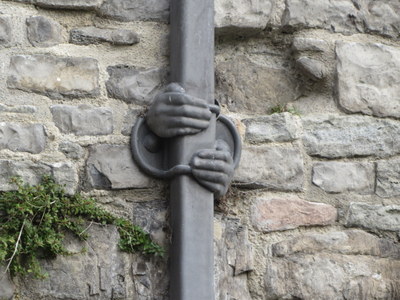
 Hands were actually a recurring theme. At the left here is a metal fixture designed to hold a downspout against the wall.
Hands were actually a recurring theme. At the left here is a metal fixture designed to hold a downspout against the wall.
At the right is a bronze model of the castle, cradled in a pair of giant stone hands (representing those of God perhaps?).
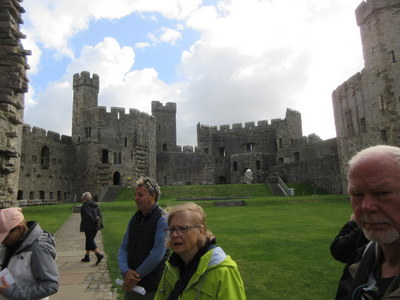
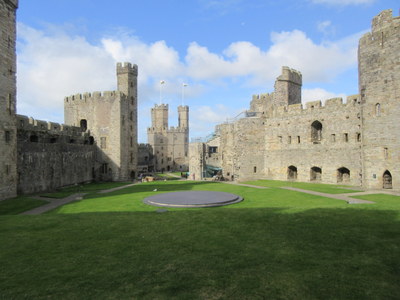
The left-hand view is from inside the castle courtyard, showing the uphill half of the castle (the side to the left as you enter the gates).
At the right, the view the other way (the half to the right as you enter the gates). The two views overlap a little, since they weren't taken from the same spot. The pointed arch at ground level at the right edge of the right-hand photo is the main gate of the castle.
I asked about the round platform in the center of the lawn, which I speculated might be the lid of a water tower, since we we were up on a hill, but no. Our guide explained that it was built for the investiture of Prince Charles as Prince of Wales, but that it is now used as a stage for plays, musical performances, and whatnot. It will not be used again for an investiture. In fact, only two princes of Wales have been formally invested—someone came up with the idea in 1911 when Edward VIII (the one who abdicated in favor of Elizabeth II's father and became the Duke of Windsor) came of age. The Welsh didn't much like the idea then, and the next time the occasion arose—Charles was the next Prince of Wales to come up, in 1969—they really didn't like it and were pretty vocal on the subject. So the practice has been discontinued. William is still Prince of Wales, but nobody came here on his 21st birthday to rub Welsh noses in it.
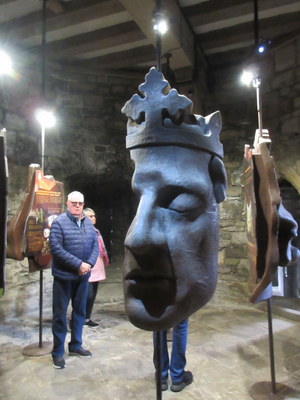
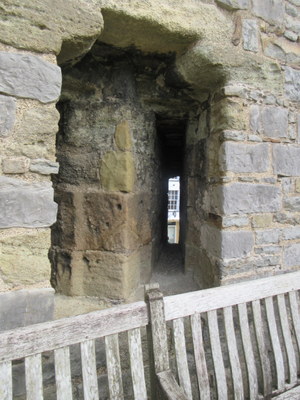 The older, carefully planned and built walls included rooms and passageways right within their thickness, which we got to walk through on our tour. Some of the rooms house museum displays on, e.g., life in the castle and the king's military campaigns. The last two panels to be filled in though, after the rabble took the castle were much thinner and included no internal structure. They did, however, include a much more advanced arrow-slit design. The older design consisted of a narrow slit through which arrows could be shot (but that presented a very small target for incoming missiles), backed by a wedge-shaped opening in the wall that permitted the archer to pivot to cover perhaps a 30° field of fire.
The older, carefully planned and built walls included rooms and passageways right within their thickness, which we got to walk through on our tour. Some of the rooms house museum displays on, e.g., life in the castle and the king's military campaigns. The last two panels to be filled in though, after the rabble took the castle were much thinner and included no internal structure. They did, however, include a much more advanced arrow-slit design. The older design consisted of a narrow slit through which arrows could be shot (but that presented a very small target for incoming missiles), backed by a wedge-shaped opening in the wall that permitted the archer to pivot to cover perhaps a 30° field of fire.
The newer design, shown here at the right, gave each archer two slits, and thus two overlapping fields of fire, each with considerable lattitude. The guide emphasized that, although the longbow originated in Wales, the soldiers manning this castle would have used crossbows. She mentioned, though, that drawing a Medieval longbow took 150 lb of pressure, the largest 350 lb! And those archers could launch six flights a minute. Welsh archers did a serious number on the fighting French aristocracy at Agincourt.
She also explained how the "plumbing" (actually stone channels rather than metal pipes) worked. As she put it, Medieval history boiled down to carnage and sewage.

 Here's a different, nearer view of the bronze model of the castle and (at the right) a small siege engine (a trebuchet? catapult? I don't remember all the differences, and I didn't get a very close look at this one) standing in a corner.
Here's a different, nearer view of the bronze model of the castle and (at the right) a small siege engine (a trebuchet? catapult? I don't remember all the differences, and I didn't get a very close look at this one) standing in a corner.
The guide was at pains to point out that Henry and Edwards did not go about the countryside building ruins. When this place was active, the entire open courtyard of the structure would have been full of smaller structures, built against the walls or in the center. You can still see the places where stone walls were attached to the inside of the outer wall and extended into the interior space, as well as corbels sticking out that held wooden upper floors (accommodations were always on upper levels, because wooden floors were so much warmer than stone ones). The larger windows would have been glass, and the stone walls would have been plastered with lime plaster and whitewashed. The lime was burned here on site for making both plaster and mortar.
Perhaps the most surprising information of all is that the garrison of this vast pile was just 28 men! About 14 would have been crossbowmen, plus an armorer, a night watchman, a carpenter, a blacksmith, a baker, a butcher, etc. They would have worn leather caps and padded jackets, not armor.
All this is known because amazing records were kept (for example, a glazier named Simon was paid a shilling per window to put in the glass). Individual workers can be traced from castle to castle as they finished their work at one and moved on to the next. The names of the captains of the ships that brought all the materials are known, as are how much it cost, and where it came from. The wooden ceilings are Canadian oak, brought as ballast in the ships that took local slate to Quebec and brought back merchandise.
All the castles in the chain were built on the sea front, or next to a tidal river, for ease of supply. Carnaerfon doesn't run out of water; it has two wells and a huge rainwater cistern. Water was pulled up in buckets and poured into a head tank, from which it was piped to the kithen.
At the end of the tour, our guide explained that the industrial revolution had a big impact on the steel and coal country in the south of Wales, which boomed. Many people moved in because of that, diluting the frequency of Welsh speakers. The king instituted a requirement to speak English, and in school, they beat the Welsh language out of the kids. Here in north wales, where they had slate rather than coal, the effect was less, but it was still 2003 before the Welsh language had status equal to that of English in its own land.
Our guide was definitely antiroyal but not necessarily nationalist. And she was sorry to see the investiture be discontinued because it was so good business, bringing lots of visitors, attention, and money.
She covered a lot more of Welsh history, including the stories of Owain Glynd�ŵr (anglicized as Owen Glendower; see, another example of w as a vowel in Welsh) and how the Welsh Henry Tudor defeated Richard III at Bosworth Field and claimed the throne of England by right of conquest, but my notes are not coherent enough to make good sense of—these are easily Googled topics, if you're interested. Cromwell at one point ordered the town, which he defeated, to blow up the castle. They promised to do, but then didn't, and got away with it, so we're still able to come tour it. The guide said you can still see bullet holes from the time of Cromwell, but she didn't show them to us.

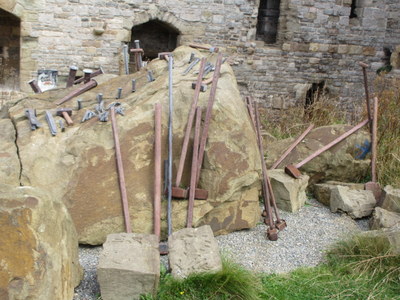 On our way out of the castle, we passed this display of the tools used by the stone masons to but and shape the stones, mostly wedges and mallets of various sizes for splitting larger stones into smaller ones.
On our way out of the castle, we passed this display of the tools used by the stone masons to but and shape the stones, mostly wedges and mallets of various sizes for splitting larger stones into smaller ones.
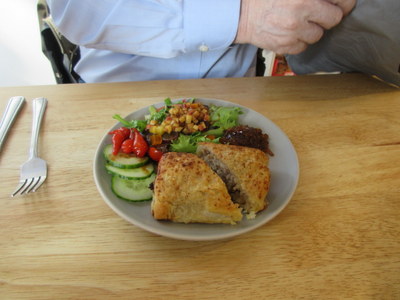
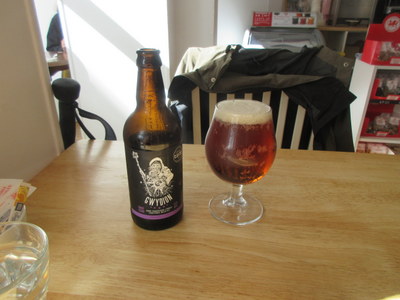 We then had an hour and a half on our own to find lunch and explore the town, which was immediately outside the gates. The pub I had picked out (The Palace Vaults) didn't open until noon, too late for us, so we wound up at Bonta Deli next door, a brand new spot recommended by Stefano. David had an ale and a "sausage roll salad bowl."
We then had an hour and a half on our own to find lunch and explore the town, which was immediately outside the gates. The pub I had picked out (The Palace Vaults) didn't open until noon, too late for us, so we wound up at Bonta Deli next door, a brand new spot recommended by Stefano. David had an ale and a "sausage roll salad bowl."

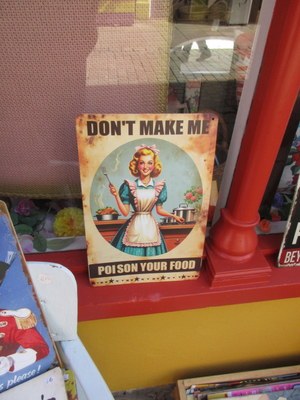 I got a "pork pie salad bowl." As you can see, it wasn't very bowl-like. The sausage roll was warm, but the pie was (intentionally) cold, but both were very tasty, especially with the crunchy onion marmalade served with them. The salads were a few salad greens topped by a generous portion of finely diced apple, halved grapes, and diced bell pepper in a balsamic dressing, in turn surrounded by cucumber, cherry tomatoes, and tiny sweet teardrop peppers.
I got a "pork pie salad bowl." As you can see, it wasn't very bowl-like. The sausage roll was warm, but the pie was (intentionally) cold, but both were very tasty, especially with the crunchy onion marmalade served with them. The salads were a few salad greens topped by a generous portion of finely diced apple, halved grapes, and diced bell pepper in a balsamic dressing, in turn surrounded by cucumber, cherry tomatoes, and tiny sweet teardrop peppers.
A nearby poster advertised Bonta "Artisan Welsh Ice Cream," in English and in Welsh (the word for artisan was "crefftwr," clearly cognate with "crafter" and using w as a vowel), so for dessert, I had a scoop of excellent raspberry ripple ice cream.
On our after-lunch stroll back to the bus, I spotted this wonderful little poster in a shop window.
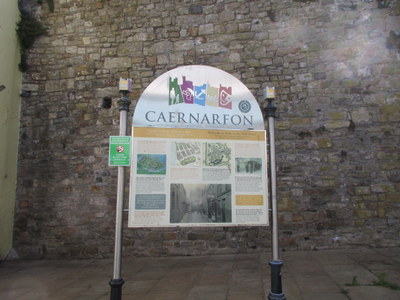
 The town itself has a rich history and much to see in addition to the castle. Posters like this one guide you through it.
The town itself has a rich history and much to see in addition to the castle. Posters like this one guide you through it.
Also on the way back to the bus was this monumental statue of favorite son David Lloyd George, prime minister of the U.K., member of Parliament from this borough, and at one point Constable of Carnaerfon Castle.
The bus then took us back to Conwy, where some people got off to explore a different castle (the one I could see from my balcony). They then had the option to walk about 45 minutes back to the hotel or to wait for the bus to come back for them a couple of hours later. We stayed on the bus back to the hotel so David could nap and I could transcribe notes.
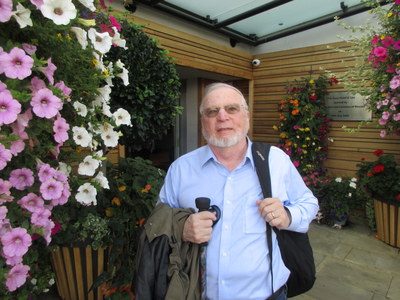
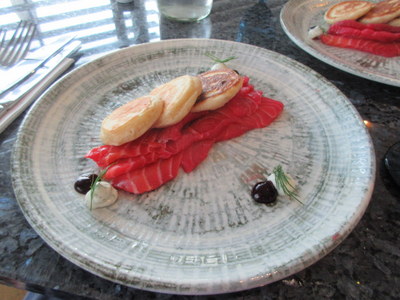 The hotel was exceptionally well supplied with hanging pots of flowers. At the left here are just a few, with David for scale. Next to David are just petunias, but behind both elbows are massed groups of multicolored and multiformed tuberous begonias. Thrown in here and there were a few geraniums and some little yellow flowers.
The hotel was exceptionally well supplied with hanging pots of flowers. At the left here are just a few, with David for scale. Next to David are just petunias, but behind both elbows are massed groups of multicolored and multiformed tuberous begonias. Thrown in here and there were a few geraniums and some little yellow flowers.
We had dinner at the hotel. It was one of those meals where each couple made a reservation at a time they found convenient. We ordered whatever we wanted from the full menu, and Tauck picked up the bill, except for alcoholic beverages. So we got three courses for the price of one glass of wine.
We both started with the "Nordic style lemon and gin cured gravlax salmon," which came with crème fraiche, juniper, and buttermilk pancakes. It was great!

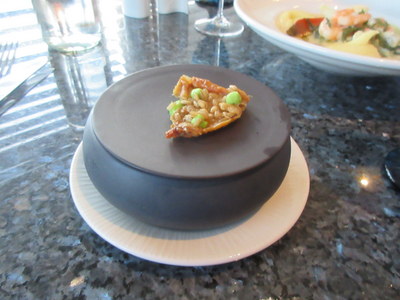 David's main course was cod, salmon, and king prawns on mashed potatoes, accompanied by samphire, broccolini, and another of those great confit, honey-glazed carrots, all smothered in a creamy seafood sauce. Also great!
David's main course was cod, salmon, and king prawns on mashed potatoes, accompanied by samphire, broccolini, and another of those great confit, honey-glazed carrots, all smothered in a creamy seafood sauce. Also great!
I chose a rich barley pilaf (I love barley, but David complains it's like eating pussy willows). It came in this covered crock topped with a little pastry triangle with barley on top.
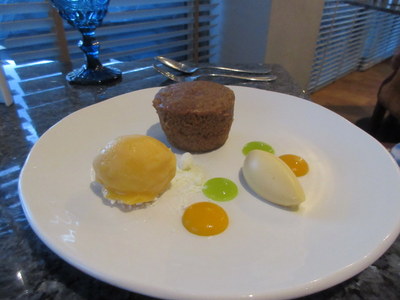
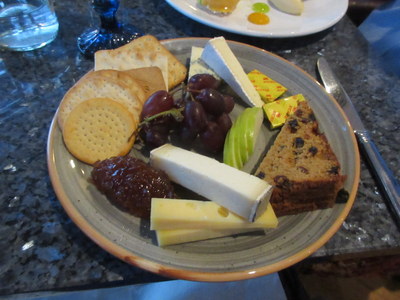 David's dessert came in three parts, a cupcake-like thing and two quenelles of what look like sorbets—mango and lemon maybe?
David's dessert came in three parts, a cupcake-like thing and two quenelles of what look like sorbets—mango and lemon maybe?
I chose the assortment of three local cheeses. All good, but not very distinctive. What I can't understand is why they go to the trouble to assemble this gorgeous presentation, then leave the butter pats in those tacky foil wrappings! The fruit bread (a local specialty whose name I've forgotten) and all the different kinds of crackers, as well as the grapes, fig jam, and sliced apple went beautifully with the cheeses.
Previous entry
List of Entries
Next entry

 The guide who presented our one-hour tour was great, but to say that she was an antiroyalist would be an understatement. She never lost an opportunity to take a dig at the English or the crown. Stefano seemed a little embarrassed, but I thought she was hilarious.
The guide who presented our one-hour tour was great, but to say that she was an antiroyalist would be an understatement. She never lost an opportunity to take a dig at the English or the crown. Stefano seemed a little embarrassed, but I thought she was hilarious.
 Hands were actually a recurring theme. At the left here is a metal fixture designed to hold a downspout against the wall.
Hands were actually a recurring theme. At the left here is a metal fixture designed to hold a downspout against the wall.


 The older, carefully planned and built walls included rooms and passageways right within their thickness, which we got to walk through on our tour. Some of the rooms house museum displays on, e.g., life in the castle and the king's military campaigns. The last two panels to be filled in though, after the rabble took the castle were much thinner and included no internal structure. They did, however, include a much more advanced arrow-slit design. The older design consisted of a narrow slit through which arrows could be shot (but that presented a very small target for incoming missiles), backed by a wedge-shaped opening in the wall that permitted the archer to pivot to cover perhaps a 30° field of fire.
The older, carefully planned and built walls included rooms and passageways right within their thickness, which we got to walk through on our tour. Some of the rooms house museum displays on, e.g., life in the castle and the king's military campaigns. The last two panels to be filled in though, after the rabble took the castle were much thinner and included no internal structure. They did, however, include a much more advanced arrow-slit design. The older design consisted of a narrow slit through which arrows could be shot (but that presented a very small target for incoming missiles), backed by a wedge-shaped opening in the wall that permitted the archer to pivot to cover perhaps a 30° field of fire.
 Here's a different, nearer view of the bronze model of the castle and (at the right) a small siege engine (a trebuchet? catapult? I don't remember all the differences, and I didn't get a very close look at this one) standing in a corner.
Here's a different, nearer view of the bronze model of the castle and (at the right) a small siege engine (a trebuchet? catapult? I don't remember all the differences, and I didn't get a very close look at this one) standing in a corner.
 On our way out of the castle, we passed this display of the tools used by the stone masons to but and shape the stones, mostly wedges and mallets of various sizes for splitting larger stones into smaller ones.
On our way out of the castle, we passed this display of the tools used by the stone masons to but and shape the stones, mostly wedges and mallets of various sizes for splitting larger stones into smaller ones.
 We then had an hour and a half on our own to find lunch and explore the town, which was immediately outside the gates. The pub I had picked out (The Palace Vaults) didn't open until noon, too late for us, so we wound up at Bonta Deli next door, a brand new spot recommended by Stefano. David had an ale and a "sausage roll salad bowl."
We then had an hour and a half on our own to find lunch and explore the town, which was immediately outside the gates. The pub I had picked out (The Palace Vaults) didn't open until noon, too late for us, so we wound up at Bonta Deli next door, a brand new spot recommended by Stefano. David had an ale and a "sausage roll salad bowl." 
 I got a "pork pie salad bowl." As you can see, it wasn't very bowl-like. The sausage roll was warm, but the pie was (intentionally) cold, but both were very tasty, especially with the crunchy onion marmalade served with them. The salads were a few salad greens topped by a generous portion of finely diced apple, halved grapes, and diced bell pepper in a balsamic dressing, in turn surrounded by cucumber, cherry tomatoes, and tiny sweet teardrop peppers.
I got a "pork pie salad bowl." As you can see, it wasn't very bowl-like. The sausage roll was warm, but the pie was (intentionally) cold, but both were very tasty, especially with the crunchy onion marmalade served with them. The salads were a few salad greens topped by a generous portion of finely diced apple, halved grapes, and diced bell pepper in a balsamic dressing, in turn surrounded by cucumber, cherry tomatoes, and tiny sweet teardrop peppers.
 The town itself has a rich history and much to see in addition to the castle. Posters like this one guide you through it.
The town itself has a rich history and much to see in addition to the castle. Posters like this one guide you through it.
 The hotel was exceptionally well supplied with hanging pots of flowers. At the left here are just a few, with David for scale. Next to David are just petunias, but behind both elbows are massed groups of multicolored and multiformed tuberous begonias. Thrown in here and there were a few geraniums and some little yellow flowers.
The hotel was exceptionally well supplied with hanging pots of flowers. At the left here are just a few, with David for scale. Next to David are just petunias, but behind both elbows are massed groups of multicolored and multiformed tuberous begonias. Thrown in here and there were a few geraniums and some little yellow flowers.
 David's main course was cod, salmon, and king prawns on mashed potatoes, accompanied by samphire, broccolini, and another of those great confit, honey-glazed carrots, all smothered in a creamy seafood sauce. Also great!
David's main course was cod, salmon, and king prawns on mashed potatoes, accompanied by samphire, broccolini, and another of those great confit, honey-glazed carrots, all smothered in a creamy seafood sauce. Also great!
 David's dessert came in three parts, a cupcake-like thing and two quenelles of what look like sorbets—mango and lemon maybe?
David's dessert came in three parts, a cupcake-like thing and two quenelles of what look like sorbets—mango and lemon maybe?